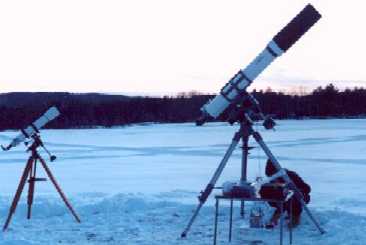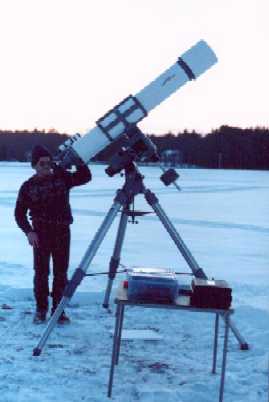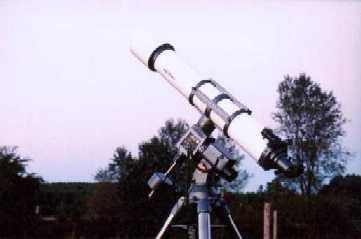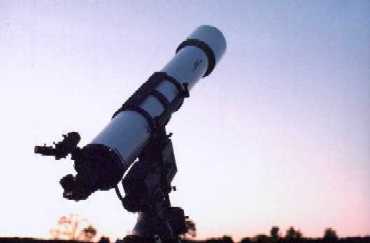Meade's Massive APO The 178ED 7" Refractor
Updated Feb 16, 1998 Updated Sept 17, 1998 Updated Feb 9, 2002
(7" f/9 Apochromatic refractor, LX750 equatorial mount, drives, #1697 computer, 8X50 finder, 26 mm Plossl, 2" visual back & diagonal, $6790 as tested) "Well, what do you see?" It was me, hopping up and down to keep warm. "Tell you in a minute," said Mike. I could see him racking the focuser back and forth. We were playing with Mike's new Meade 7" APO refractor. The scope is huge - you knew that - but the pictures, here and in Meade's catalog, don't do it justice. The thing is just massive. It's so large that Mike cannot store it, assembled, in his house. With the tripod collapsed, the cradle still comes perilously close to the ceiling. "Well?" I was getting impatient. "Here, you look." I sidled up to the eyepiece, one hand on the focuser, and looked. The star was Saiph in Orion. In and out the focuser went. In and out. And I can tell you what I saw...
But, we're getting ahead of ourselves. The full story of this particular Meade 178ED APO goes back almost five months, to a warm early-fall afternoon in 1997, when the scope was first purchased.
Chapter One: The Scope Strikes Out This sample was purchased new by a friend of mine (we should all have such friends!) from a local dealer. He went in to buy a Firstscope 80, and walked out with the Meade. Doesn't it always work that way? The scope was well packed in six different cartons. According to Mike, the instructions were clear and well thought out. Getting out to the field with a scope of this size can present problems, as you can imagine. However, with a small to mid-size car and some imaginative loading, the 178 ED fits, and still qualifies as a "portable" instrument. Setup can be accomplished by one person. None of the steps in the setup are particularly complicated; there's just lots of 'em. Meade has done a good job of breaking down the assembly into bite-sized pieces. Briefly, here's how the scope gets set up: 1) Open up the legs of the tripod on level ground. 2) Set the equatorial head on top of the tripod base and screw down tightly. 3) One by one, extend the legs of the tripod (you have to do this carefully). 4) Attach the counterweight (and the declination shaft, if you took it off in transport.) 5) Attach the cradle to the equatorial head. Rotate the cradle to horizontal. 6) Place the tube in the cradle and tighten down the wing nuts. This is hard to do if you're shorter than about 5' 8". Remove the dust cap. 7) Attach the dew shield with one bolt. Attach an additional dew shield if you use one. 8) Attach the finder (it's a hassle, but leaving the finder attached to the OTA is asking for trouble). 9) Plug in your diagonal and attach all your electrical cables. Set up can be done in about twenty minutes, if you take your time and do it right. I should point out that in the dead of winter, the twenty minutes it takes to do all this stuff in reverse at the end of your observing session can seem like an eternity.

Chapter Two: The Scope Returns Another 5 weeks passed. One day, Mike got word that the OTA had been returned to the dealer. I went with him to get it, first thing on a Saturday morning. There was no note, no repair slip, no paperwork at all. We agreed to meet that night at our usual observing spot. I showed up at dusk, and brought along my Takahashi for comparison (that's the "little" scope at the left of the first photo). I set up the Tak on the Super Polaris, then helped Mike with some lifting on the big Meade. Then we waited. The 178ED didn't seem to want to settle down. The FS102 was already delivering its usual knock-your-socks-off images on Saturn, so we enjoyed this for while. After an hour, the Meade seemed to come to equilibrium. Here is what I saw: When you defocus a star, you expect the disc of light to expand evenly around the central airy disc. This was not the case here. Rather, the disc of light seemed to grow out towards 7 o'clock. Fully defocused, the airy disc actually sits on the outer diffraction ring - very strange. Also, we could not bring Saturn to focus. The image was always a little fuzzy. Frustrated, we retired back to Mike's house, where he showed me the letter he had written, originally describing the problem to Meade in November, 1997. His description matched what I saw almost exactly. As a result, we both came to the conclusion that Meade had not done a thing to the OTA. Perhaps they had meant to, but somehow the scope just got sent back. Keep in mind, Meade had kept it for almost 2 months. Once again, arrangements were made to send the scope back, this time at Meade's expense. Three more weeks passed, and Mike again got word that the scope had returned to the dealer. Mike called Meade for a detailed explanation of what they'd done to it, but all he could get was "we collimated it," which could mean any number of things.
Chapter Three: And the Verdict is... "OK, Ed, what do you think?" Now it was his turn to hop back and forth, trying to keep warm. Mike had taken no chances this time. Instead of going to our usual spot, he set up the Big Guy in his backyard. Sure, there was some skyglow, but he wanted his tools, spare eyepieces, etc within easy reach. Here's what I saw: The scope shows very little spherical aberration. The diffraction rings looked very pleasing. However, the airy disc is still a little fan-shaped, and seems to shift just a bit when you de-focus. The scope was clearly better than before. I would estimate that they cured 90% of the problem. False centering on the objective? "V" spacing between the 2 elements? Any ideas from the readers out there? I also noticed a moderately prominent purple halo around bright objects at mid-to-high power. How Meade gets away with calling this an "apochromat" is beyond me. Saturn was low in the sky and didn't look very good. It was hard to tell whether the scope or the conditions were responsible, so we suspended judgement. Castor, Beta Monoceros, and Alnitak were split, but not cleanly. This was disturbing. Airy discs refused to remain points at high power. However, in a strange turn of events, the Meade turns out to be a superb deep-sky telescope. Even from this suburban location, the 178ED delivered perhaps the finest view of the Orion Nebula I've ever seen. Six stars were visible with direct vision in the Trapezium, and the nebulosity showed fine shadings I'd never noticed before. NGC2158, the little cluster next to M35, shows some granularity. Perhaps it could be resolved under darker skies. And I spent an enjoyable 20 minutes or so looking at M81 and M82. Conclusions The purpose of a review, in my opinion, is to reach a sort of conclusion to help a prospective buyer decide whether a particular product is right for them. In this manner, I am somewhat stymied for a concrete opinion. This particular 178ED APO is a wonderful deep-sky instrument that could keep a galaxy hunter happy for years. However, planetary and double star fans might have a different opinion. Then there is the issue of Meade's service. Mike reports that dealing with Meade's support was like fighting an uphill battle. Myself? I like the scope in its present condition. I like it a lot. Would I pay $6790 for it? Well... In the end, each user will need to decide the issue of perceived value (or lack thereof) for themselves. And that is perhaps the best conclusion I can reach.
Postscript: A New Hope? Discouraged by the performance of his 178ED, especially in continued comparisons to the FS102 and the A-P Star 12, Mike contacted Meade again and had a long talk with them about the situation. In short, he was still not satisfied with the telescope. When you pay almost $7000 for a refractor, you expect it will provide excellent views of the planets and double stars. This one doesn't. Meade agreed, and made arrangements to take the OTA back for a third time. This time they kept the scope for a long time, from April through mid-September of 1998. During this period there were a number of conversations between Mike and the factory. Meade assured him that they were taking the situation seriously. The opticians, he was told had rejected "a half dozen or so" lenses for Mike, and were looking for an outstanding sample for him. As a result of these conversations alone, Meade's customer service seemed to improve dramatically. However, this was a modest consolation at best, since Meade had kept the scope, on and off, for almost 10 months now. In early September, Meade sent the OTA back to Mike. In conversations with him, the message given by Meade was something to the effect of, "This is our best, we cannot do any better than this one." Still, to say that he was apprehensive would be an understatement. Mike was visibly nervous all week and did not look forward to having another conversation with the factory should this OTA prove to be as unsatisfactory as the others (I am sure that Meade had a similar outlook at this point.) After spending a night alone with the new 178ED, he invited me to take a look through the scope. And here is what I saw. A quick inspection of the glass is revealing. The coatings seemed much better than before. The lenses were so dark I could barely see a reflection of myself, even with a lamp right behind me. The lens was slightly mis-collimated, but this was easily corrected. Seeing the 178ED set up, I am once again struck by how beautiful the scope is. It cuts a striking pose against the setting sun. Whoever at Meade was responsible for the scope's aesthetics really outdid themselves this time.

 Proud Flagship or White Elephant? Meade's 178ED APO
Proud Flagship or White Elephant? Meade's 178ED APOFinal Update, 2/9/02: The End During a test at my place comparing a Takahashi to an AP, one of the metal baffles in the OTA broke loose and lodged itself near the focuser. Once more the scope was sent back to Meade. A few weeks later it returned. By this time Mike noticed that the scope was having significant trouble retaining its collimation; even the act of driving it to a remote location was enough to knock it out of whack. Readers have told me that Meade is offering a new lens cell that is said to hold the lenses more firmly. The cost is reasonable, about $100-$200 plus shipping. After contemplating yet another trip for the scope back to Meade (this would have been the fifth trip back to the factory in 4 years) Mike finally decided it was time to move on. A buyer was found, and Mike spent hours on the phone with the potential purchaser, explaining everything he knew about the scope. He wanted the buyer to be absolutely sure he knew what he was getting into. The scope left NH for the last time in February of 2002. -The End! (Note: See also reviews of the 4" 102ED and the 6" 152ED models in this series) End Review of Meade 178ED APO
Back to Home Page